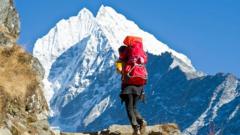Are You Ready to Explore 97 Free Climbing Peaks in Nepal as Everest Tourism Soars?

Nepal Opens 97 Himalayan Mountains for Free Climbing: A New Era for Tourism
In an ambitious move to revitalize its tourism industry, Nepal has announced that it will waive climbing fees for 97 of its Himalayan mountains over the next two years. This initiative aims to draw attention to some of the more remote and less explored regions of the country, particularly in Karnali and Sudurpaschim provinces. In light of recent permit fee hikes for summiting Mount Everest, Nepal's tourism department is looking to diversify its offerings while boosting economic opportunities in underdeveloped areas. This strategic decision could redefine the climbing landscape in Nepal and contribute significantly to the local economy.
The Context Behind the Initiative
Nepal is home to the world's ten tallest mountains, including Mount Everest, which stands at a staggering height of over 8,849 meters (29,032 feet). Historically, mountaineering has been a major contributor to the country's economy, generating substantial revenue through climbing permits. In the previous year alone, climbing fees brought in approximately $5.9 million, with Everest accounting for more than 75% of that total.
However, the tourism landscape in Nepal is not without its challenges. The recent increase in permit fees for Everest climbers, which will rise to $15,000 during peak season starting September, has raised concerns about accessibility and the sustainability of tourism in the region. This fee hike marks the first increase in nearly a decade and is part of broader efforts to manage the environmental impacts and overcrowding associated with Everest expeditions.
Exploring the 97 Free Peaks
The mountains for which climbing fees will be waived are situated in the Karnali and Sudurpaschim provinces. These peaks, ranging in height from 5,970 meters (19,590 feet) to 7,132 meters, offer breathtaking views and challenging climbing experiences. Yet, despite their stunning beauty, these regions remain largely untouched by the influx of tourists, primarily due to their remote locations and difficult access routes.
Himal Gautam, the director of Nepal's Tourism Department, stated, "Despite their breathtaking beauty, the number of tourists and mountaineers here is very low as access is so difficult. We hope the new provision will help." This initiative is expected to create jobs, generate income, and ultimately strengthen the local economy in these impoverished provinces.
The Potential Economic Impact
By waiving climbing fees, Nepal aims to stimulate economic growth in Karnali and Sudurpaschim. The influx of climbers can lead to various benefits:
- Job Creation: Local communities can benefit from new employment opportunities in hospitality, guiding services, and other tourism-related sectors.
- Income Generation: Increased tourist arrivals can lead to a rise in local business revenues, from hotels to restaurants and shops.
- Infrastructure Development: With more tourists, there may be a push for improvements in roads, accommodations, and other essential services.
Challenges Ahead
While the initiative has the potential to bring significant benefits, it also raises several questions regarding the preparedness of local communities and infrastructure. The government has not yet provided clear plans for improving access to these remote areas, which may limit the success of the initiative. Without adequate roads and facilities, the influx of climbers could strain local resources, leading to potential backlash from communities that have historically been isolated from tourism.
Past Trends in Climbing in Nepal
Historically, climbers have shown little interest in these 97 remote peaks. In the last two years, only 68 climbers ventured into this area, a stark contrast to the 421 climbing permits issued for Everest in 2024 alone. This disparity highlights the overwhelming popularity of Everest compared to other mountains in Nepal, despite their potential for adventure and exploration.
Environmental Considerations
With the increasing popularity of climbing in Nepal, environmental concerns have also surged. Mount Everest, in particular, has faced challenges related to overcrowding and waste management. In response, Nepal's Supreme Court ordered the government to limit the number of mountaineering permits issued, emphasizing the need to respect the mountains' capacity. As the number of climbers increases, the environmental impact on these remote areas must also be carefully managed.
Future Regulations for Everest Climbers
In addition to the new fee structure, Nepal's parliament is currently debating legislation that would require climbers to have previously summited a mountain over 7,000 meters within the country before attempting Everest. This regulation aims to ensure that climbers possess sufficient experience and skills for the challenging conditions found at higher elevations. The 97 peaks in Karnali and Sudurpaschim could serve as ideal training grounds for aspiring Everest climbers.
Conclusion: A New Chapter for Nepal's Tourism
Nepal’s initiative to waive climbing fees for 97 Himalayan mountains marks a pivotal moment for the country’s tourism strategy. By encouraging exploration of less-traveled areas, the government hopes to distribute the economic benefits of tourism more evenly across the country. While this initiative presents exciting opportunities for local communities and climbers alike, it will require careful planning and management to ensure that the benefits outweigh the challenges.
As we look to the future, one must ponder: How will the influx of climbers affect the cultural and environmental landscape of these remote regions? Will Nepal successfully balance the demands of tourism with the need to protect its natural heritage?
FAQs
What mountains in Nepal are free to climb for the next two years?
Nepal has announced that 97 Himalayan mountains, primarily in the Karnali and Sudurpaschim provinces, will be free to climb for the next two years.
Why is Nepal waiving climbing fees?
The initiative aims to boost tourism in remote areas, create jobs, and strengthen the local economy, particularly in some of the country’s poorest regions.
What are the current permit fees for climbing Mount Everest?
As of September, the permit fee for climbing Mount Everest during the peak season will increase to $15,000. Fees for climbing during the off-peak season will also rise, with costs varying based on the time of year.
Are there any new regulations for climbers attempting Everest?
Yes, Nepal's parliament is discussing a new law requiring climbers to have first summited a mountain over 7,000 meters within the country before they can attempt Everest.
As Nepal embarks on this new chapter in its tourism journey, it will be interesting to see how these policies reshape the climbing experience in this breathtaking country. Will this initiative lead to sustainable tourism practices in the Himalayas? #NepalTourism #HimalayanClimbing #SustainableTravel
Published: 2025-08-12 05:14:15 | Category: technology



